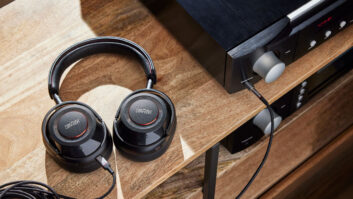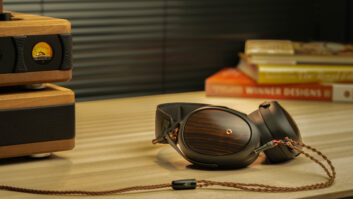When I accepted an offer to check out Westone’s custom-made in-ear headphones, I never expected I’d need a bottle of lube to complete my review.

Westone’s ES3 custom in-ear headphones in ice blue.
I first learned about Colorado Springs-based Westone this past September at CEDIA EXPO, where the company’s publicist told me about his client’s extensive background serving the in-ear monitoring market for musicians and how it had expanded into the earphone market by adapting its product line accordingly. I acknowledged that I’d never been a big fan of traditional in-ear earbuds (the kind with the multiple sizes of rubber tips) but that I’d always wondered how a custom pair, which looked like what rock stars wore as monitors in concert, would feel and perform.
A couple weeks after the show, I was directed to Westone’s website to select the model I would be trying out—the top-of-the-line Custom ES5, which feature 120 dB at 1mw sensitivity, a frequency response of 8 Hz to 20 kHz, impedance of 20 ohms at 1kHz, five balanced armature drivers with passive three-way crossover, and Westone EPIC removable cable—for a cool $950 MSRP.
After that I was asked to choose an earphone color (translucent “ice blue”), “faceplate,” which adds an extra graphical layer to the in-ears (I turned down this $62.50 per earpiece option), a stock or custom graphic design option (none for me, either, thanks, I don’t like to draw too much attention to myself; it would have cost $37.50 per earpiece, by the way), and cable color and length (50-inch, silver, but I could have chosen a putty or black color in 50- or 64-inch lengths. I also could have requested for the ear styles to be the same on both ears or different; I went with symmetry.
Next, Westone arranged an appointment for me at a local audiologist’s office to have impressions of my ear canal made. I was a little nervous about this part of the process, but it couldn’t have been more pleasant as the cool clay material was squeezed into my ear and set for a few minutes, after which I left with strange looking shapes with strings on the ends of them (to retrieve the molds out of my ears) in a pre-paid shipping box already return-addressed to Westone’s Colorado HQ.

I was a little nervous about this part of the process, but it couldn’t have been more pleasant as the cool clay material was squeezed into my ear and set for a few minutes, after which I left with strange looking shapes (pictured) with strings on the ends of them (to retrieve the molds out of my ears) in a pre-paid shipping box already return-addressed to Westone’s Colorado HQ.
A couple of weeks later, I received my custom in-ear headphones via courier. They arrived in a sturdy hard plastic case containing, which also contained a small cleaning brush/pick, a cleaning cloth, a container of desiccate gel beads to keep the phones dry, and that bottle of lube that I mentioned before. About that lube… it wasn’t the type of gel one would find in the condom aisle at the local CVS. Labeled “OTO-EASE,” it is apparently marketed specifically to the hearing aid and in-ear monitor markets, and isn’t a requirement for wearing the in-ears, but it does have its benefits. Following Westone’s instructions, I lightly applied a bit of the odorless clear gel to the tips of the in-ears, tugged down on my earlobe a bit, inserted the monitor, twisted it slightly to get it to set properly, and instantly the outside auditory world was shut out. The OTO-EASE gel definitely helped prevent the abrasive feel that previous earbuds had caused, and it also provided a better seal to lock out sounds and lock in music.
I’ve always felt a bit claustrophobic while wearing “standard-issue” in-ear earbuds. So, I was surprised by how comfortable the Westone custom in-ear headphones felt after an initial test run. The OTO-EASE gel helped with this, no question, but the lighter weight of the earphones added to my comfort, and I eventually found the sweet spot where I the seal didn’t cause me to “hear my head” as I swallowed or chewed.
The performance results have been great, as well. By sealing in the sound, bass is richer than any other in-ears I’ve experienced, and the sound insolation provides a purer musical experience. After comparing familiar songs, I found that I had to change the EQ settings on the iPhone Music app from “bass booster,” which has provided the best my Apple white factory earbuds could offer, to the “treble booster” setting, which has provided crisper vocals without losing the rich bass and drums, even on a heavily layered tune like Eminem’s new release, Berzerk.
The best test came when I used the Westones while mowing my lawn. Not only did they seal off the noise from my mower, but that characteristic enabled me to lower the volume on what I was listening much below where I’d normally have it. Previously, even over-ear phones required me to turn up the volume of a podcast, for instance, to hear dialogue over the roar of my mower. So, now my ears were protected from engine noise and kept safe from high-volume audio. That being said, I’m still adjusting to the closed-off world created by the Westones, when I’m out walking my dog or working out at the gym. And forget about driving with them on. That’s a recipe for disaster. I also miss having an in-line volume control on the cord that enables me to receive phone calls without fumbling for my phone or turn off my music or podcast efficiently when someone asks me a question.
All in all, I’m a big fan of Westone’s custom in-ear headphones and think that any custom integrator that cares about the best sounding and best looking portable audio experience, should fork over the big bucks and try these babies out. The price point and custom nature of Westone’s in-ear headphones line seem like a great match for retail-centric custom integrators, even if the audiologist aspect of the process could provide a new twist on traditional business partnerships.







